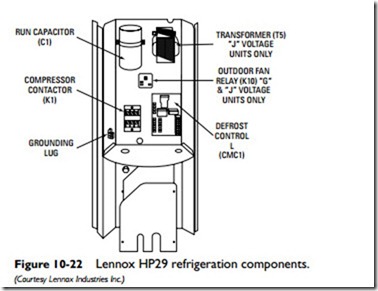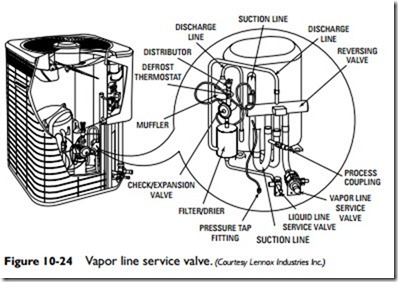Service Valves and Gauge Ports
As shown in Figure 10-22, service valves are installed in the liquid and vapor lines of the heat pump. These valves are used to charge
the system (and check the charge), to test for leaks, and to evacuate the system. Each valve is equipped with a service port containing a factory-installed Schrader valve covered by a protective cap. The service port cap functions as the primary leak seal. Cutaway views of the liquid line and vapor line service valves are illustrated in Figures 10-23 and 10-24.
Gauge Manifold
The gauge manifold is a device equipped with two gauges (see Figure 10-25). One of the gauges measures suction (low) pressure, whereas the other gauge measures head (high) pressure. These gauges indicate how well the compressor is removing the heat collected by the evaporator coil, how well the condenser coil is expelling the heat, and the amount of load placed on the heat pump. An efficient heat pump will have a high suction pressure and a low head pressure.
Filter Dryer
The filter dryer (also called bi-flow filter dryer) is used to remove dirt, other contaminants, and moisture from the refrigerant before it can damage the compressor and other components in the heating system.
Crankcase Heater
When some heat pumps are shut down during the cold winter months, the liquid refrigerant may enter the compressor crankcase
and mix with the lubricating oil. When the heat pump is turned on again, the refrigerant in the crankcase evaporates rapidly and forms a foam. This condition dilutes the oil, prevents adequate lubrication, and may shorten the service life of the compressor. A crankcase heater will prevent the refrigerant from liquefying in the lubricating oil. Some crankcase heaters are designed to operate all the time; others only when required. Crankcase heaters are not required on scroll compressors.
Muffler
As shown in Figure 10-13, a muffler is installed in the discharge line to minimize noisy pulsations and vibrations. The muffler greatly reduces the sound inside the house of compressor operation.


